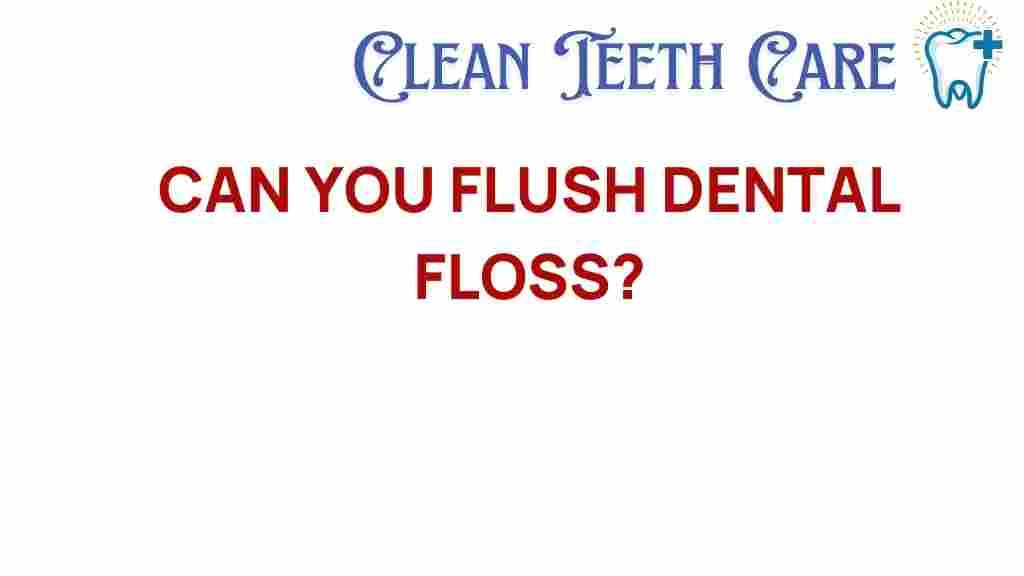Is Flushing Dental Floss a Hidden Hazard for Your Plumbing?
Many people believe that dental floss is a harmless item that can be disposed of easily by flushing it down the toilet. However, this common practice can lead to serious plumbing issues and potential environmental hazards. In this article, we’ll explore the implications of flushing dental floss, the importance of plumbing safety, and how to manage wastewater more effectively. We’ll provide essential household tips to ensure proper waste disposal while maintaining home hygiene.
The Risks of Flushing Dental Floss
Flushing dental floss might seem convenient, but it poses several risks:
- Clogs and Blockages: Dental floss is made from synthetic materials that do not break down easily. When flushed, it can accumulate in pipes, leading to severe clogs.
- Plumbing Issues: Flushing items like dental floss can strain your plumbing system, causing pipes to crack or burst over time.
- Environmental Impact: Flushed dental floss can contribute to pollution in water bodies, harming marine life and ecosystems.
Understanding Plumbing Safety
Plumbing safety is crucial for maintaining a healthy home environment. Homeowners should be aware of what can and cannot be flushed to prevent plumbing issues. Here are some guidelines:
- Only flush human waste and toilet paper: These are the only items that are safe for flushing.
- Dispose of dental floss in the trash: Always throw away used dental floss in a waste bin instead of flushing it.
- Educate your family: Ensure that everyone in your household understands proper waste disposal methods.
Wastewater Management Practices
Proper wastewater management is essential for the health of our plumbing systems and the environment. Here are some best practices:
- Use biodegradable dental floss: If you’re concerned about the waste dental floss creates, consider using biodegradable options that are less harmful to the environment.
- Install a lint trap: For households with issues related to plumbing, installing a lint trap can help catch debris before it enters the plumbing system.
- Regular plumbing maintenance: Schedule routine inspections and maintenance for your plumbing to catch any potential issues early.
Household Tips for Waste Disposal
Maintaining a clean and safe home involves effective waste disposal practices. Here are some household tips:
- Set up a waste station: Designate a specific area for disposing of non-flushable items like dental floss, cotton swabs, and sanitary products.
- Educate children: Teach children the importance of proper waste disposal to foster good habits early on.
- Use compostable alternatives: For items that can be composted, such as certain dental products, consider using compostable alternatives.
Environmental Impact of Flushing Dental Floss
The environmental impact of flushing dental floss extends beyond plumbing issues. Here’s how:
- Water Pollution: Flushed dental floss can contribute to pollution in rivers and oceans, affecting aquatic life.
- Wastewater Treatment Challenges: Wastewater treatment facilities struggle to filter out synthetic materials, leading to higher operational costs and potential environmental damage.
- Microplastics Formation: Over time, dental floss can break down into microplastics, which are harmful to marine ecosystems.
Troubleshooting Plumbing Issues Related to Flushing Dental Floss
If you suspect that flushing dental floss has caused plumbing issues in your home, here’s a step-by-step troubleshooting process:
- Identify the Symptoms: Look for signs of plumbing issues such as slow drains, gurgling sounds, or water backup.
- Check Other Fixtures: Determine if the problem is localized to one area or affects multiple plumbing fixtures in your home.
- Use a Plumber’s Snake: If you’re comfortable, use a plumber’s snake to try to clear any blockages.
- Call a Professional: If the issue persists, it’s best to consult a licensed plumber to assess and resolve the problem.
Maintaining Home Hygiene
Maintaining home hygiene is essential for the health and safety of your family. Here are some tips to enhance hygiene while ensuring plumbing safety:
- Regular Cleaning: Clean bathrooms and kitchens regularly to prevent the buildup of grime and bacteria.
- Proper Disposal: Always dispose of dental floss, dental wipes, and other hygiene products in the trash, not the toilet.
- Use Natural Products: Consider using natural cleaning products that are less harmful to plumbing and the environment.
Conclusion
Flushing dental floss may seem like a minor convenience, but it can lead to significant plumbing issues, environmental impact, and problems with wastewater management. To ensure plumbing safety and maintain home hygiene, always dispose of dental floss in the trash and educate your family about proper waste disposal practices. By taking these steps, you can avoid plumbing problems, contribute to environmental sustainability, and keep your home clean and safe.
For more information on plumbing safety and proper waste disposal methods, visit EPA’s website for resources and guidance.
Additionally, if you want to learn more about maintaining your home’s plumbing system, check out our detailed guide on plumbing maintenance tips.
This article is in the category Hygiene and created by CleanTeethCare Team
